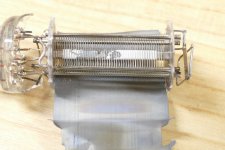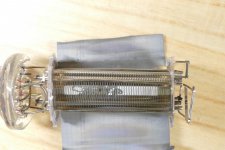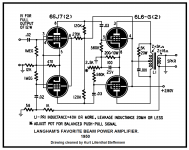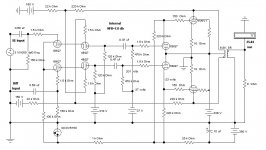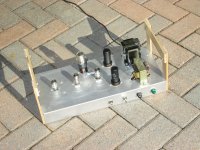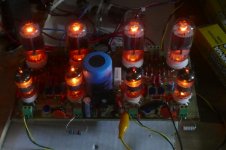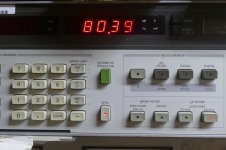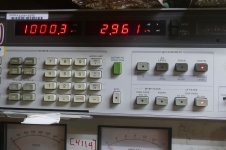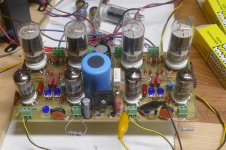If you have a pile of them you can always accept a little more heater current and put two or more in parallel.Over 20 years ago someone gave me over 100,000 loose, unsorted, untested tubes. Over a 10 year period I went through all of them throwing out the trash (broken, corroded, or otherwise unusable tubes), sorting and testing a few of each of all the type numbers that I had never seen before. Ten years ago it became apparent that my 41 year engineering career was on life support and that we would eventually move out of Florida when it ended. That began a massive "stuff" reduction program. I sold, traded or gave away lots of tubes and only kept those that I thought I may use someday. I have been in West Virginia for 8 years now, and some of my guesses as what to keep were a bit off, but most were good. For some reason, I have about 1 gallon of 5763's. I probably lit some up and leaned on them pretty hard.
I believe the clue to sucess here is in the spec sheets. 25 watts from a pair in an AUDIO amp. OK, but it's in class AB2. Daqvin Carter picked up on this. You will need to drive G1 positive to get good efficiency from this tube. I use mosfets for this, but to each, their own.
I got away with good performance with a little more plate voltage and not needing to drive the grid positive.
I really don't care about Brimar or what people dream up on the internet.
The tube is, hold on.... INTENDED...... for Radio Frequency use.
Is there a cutoff frequency where the tube stops passing a signal? Do you know something that the datasheet isn't telling us?
Simple. The 5763 is a "screened tetrode" or a traditional pentode. The 6AQ5 is a beam power tube. The 6BQ5 is a power pentode but with significantly different internal structure. You also don't state what plate loads are for the cases you suggest.Any thoughts on how the 5763 could have such low power output, with essentially the same plate voltage and current swings as the other listed tubes?
https://frank.pocnet.net/sheets/184/5/5763.pdf
Fact of the matter is you can probably get pretty good performance from the 5763 at audio frequencies. But as for what the actual performance may be I would suggest you simply do some prototyping and see how it performs. This always yields much better performance than looking at data sheets.
The 5763 is also a beam power tube. And the data sheet outputs I gave were for 5.5k (5763), 5.5k (6AQ5) and 4.5k (6BQ5). So, in my ignorance of tubes in audio service (though not of tubes in general) I'm just scratching my head at how, in particular, the 5763 and 6AQ5 can be run at the same plate voltage and current, into the same loads, and yet the 6AQ5 specs at 58% more power output.Simple. The 5763 is a "screened tetrode" or a traditional pentode. The 6AQ5 is a beam power tube. The 6BQ5 is a power pentode but with significantly different internal structure. You also don't state what plate loads are for the cases you suggest.
Fact of the matter is you can probably get pretty good performance from the 5763 at audio frequencies. But as for what the actual performance may be I would suggest you simply do some prototyping and see how it performs. This always yields much better performance than looking at data sheets.
But I will definitely do some prototyping this week. If I learn anything unusual I'll report back.
Look at the "V.A.D. 307.240" diagram in the STC report linked above. This tube has a strong "tetrode kink" at low plate voltages. It is almost impossible to get this kind of response out of a beam power tube. I would bet you a big beer that the 5763 has a screen and not beam forming plates. IMHO.The 5763 is also a beam power tube. And the data sheet outputs I gave were for 5.5k (5763), 5.5k (6AQ5) and 4.5k (6BQ5). So, in my ignorance of tubes in audio service (though not of tubes in general) I'm just scratching my head at how, in particular, the 5763 and 6AQ5 can be run at the same plate voltage and current, into the same loads, and yet the 6AQ5 specs at 58% more power output.
But I will definitely do some prototyping this week. If I learn anything unusual I'll report back.
WHACK said the hammer to the tube. I looked into my bag of 5763 tubes and it wasn't hard to find one with cathode flakes loose inside the glass and near zero getter, so I offered it up to science. I have cracked open LOTS of tubes in my nearly 60 years of tinkering with them, and I have never seen this. There are no beam forming plates, and no suppressor grid either, just 4 grid posts with no grid wire on them. This explains the tetrode kink. This tube has likely arced over a few times since there is cathode material missing from both sided of the cathode and the plate looks like its seen some redness. I wasn't being too careful when I ripped it open, so the misalignment twist was my doing.
Attachments
Really nothing connected to pin #3? The spec sheet says it is a pentode. Not that an actual tube would differ from stated specs.WHACK said the hammer to the tube. I looked into my bag of 5763 tubes and it wasn't hard to find one with cathode flakes loose inside the glass and near zero getter, so I offered it up to science. I have cracked open LOTS of tubes in my nearly 60 years of tinkering with them, and I have never seen this. There are no beam forming plates, and no suppressor grid either, just 4 grid posts with no grid wire on them. This explains the tetrode kink. This tube has likely arced over a few times since there is cathode material missing from both sided of the cathode and the plate looks like its seen some redness. I wasn't being too careful when I ripped it open, so the misalignment twist was my doing.
That's odd alright. The lack of beam forming plates in an RF amplifier tube seems, well, bizarre.WHACK said the hammer to the tube. I looked into my bag of 5763 tubes and it wasn't hard to find one with cathode flakes loose inside the glass and near zero getter, so I offered it up to science. I have cracked open LOTS of tubes in my nearly 60 years of tinkering with them, and I have never seen this. There are no beam forming plates, and no suppressor grid either, just 4 grid posts with no grid wire on them. This explains the tetrode kink. This tube has likely arced over a few times since there is cathode material missing from both sided of the cathode and the plate looks like its seen some redness. I wasn't being too careful when I ripped it open, so the misalignment twist was my doing.
I've definitely seen it before (pure tetrode with no suppressor grid or beam forming plates), but the only tube that comes to mind is a 715 / 5D21.
From careful scrutiny of Tubelab's pics, it's got two side posts with no gridding wire on them (to pin 3). Half way between a beam pentode and a tetrode. Explains the somewhat kinked curves. Wiseoldtech had it right. "Internal design is different, specifically for RF use." Fishing bobbers in other words.
Save yourself some grief. Get some 6197 tubes (similar to 6CL6 video tube) pentodes for something cheap, military, and very audio use-able. (curves below)
Or a selection like 6197, 6HB6, 6EW6, 6BN11, 12HL7, 6HZ8, 6GF5, 6LY8, 6KV8, 6KR8, 6LU8, 6FM7, 10/6JA5, 6JC5, 38HE7, 25HX5, 6CB5A, 6EX6, 12GE5, 21HB5A, 33/21JV6, 17KV6A, 6HJ5 , 21LG6A




Save yourself some grief. Get some 6197 tubes (similar to 6CL6 video tube) pentodes for something cheap, military, and very audio use-able. (curves below)
Or a selection like 6197, 6HB6, 6EW6, 6BN11, 12HL7, 6HZ8, 6GF5, 6LY8, 6KV8, 6KR8, 6LU8, 6FM7, 10/6JA5, 6JC5, 38HE7, 25HX5, 6CB5A, 6EX6, 12GE5, 21HB5A, 33/21JV6, 17KV6A, 6HJ5 , 21LG6A
Last edited:
What form would this grief take? Just an ugly sound? BTW, I happen to have a good supply of 6197s also, since they make excellent RF oscillators. Glad to see them recommended for audio use.Save yourself some grief. Get some 6197 tubes (similar to 6CL6 video tube) pentodes for something cheap, military, and very audio use-able.
Looking at an intact tube, pin 3 connects to one pair of vertical risers (for lack of a better term), and at the top of the tube is a strap connection to the other pair of risers. So all 4 risers are connected to pin 3.Really nothing connected to pin #3? The spec sheet says it is a pentode. Not that an actual tube would differ from stated specs.
What form would this grief take? Just an ugly sound?
Tetrode kinks which limit the minimum knee voltage (so low efficiency), positive grid 1 drive requiring another tube or Mosfet to drive it, probably distortion too (look at the ugly curve spacing on that 5763 datasheet! frequency multiplier or mixer duty is a dead giveaway for distortion ). That's not to say 5763 couldn't be used, just that some other tubes are just so easy to use with good results. (and cheap too)
Last edited:
The 6197 looks to be designed for driving something like a solenoid or perhaps video Z-axis driver.
The data sheet sez the cathode is designed for long off periods, in other words cathode interface.
Or perhaps as a vertical amp in an early scope where cathode interface was a problem.
Might be found in some early 50s data processing equipment.
To stir this pot further, if one is adventurous why not try the 5763 as a voltage amplifier in an
amp such as the attached. Its only a tube, not particularly special aside from what the manufacturer
thinks is a best fit. The OP seems to have a fleet of these toobz. The cct as shewn needs some
components values changed but not a big deal at all.
The cct is very innovative & gets a lot done with a few toobz. Notice the designer did not bypass
the screens of the driver, this has a balancing effect similar to an unbypassed cathode resister.
Running large value resisters on the plate & screens of the driver reduces the gm so there is
less likely to be self oscillation in the driver stage. For a first pass omit some of the frills such as
the AC balance control & the RC network across the OPT primary.
The end product will be the same as most other toob amps on this forum, which kind of distortion
do we like best. For an experienced designer this one is a 'no brainer'. 🙂
But still only 5W at best. Looks like it makes a good AM modulator in Class AB2 tho.
The data sheet sez the cathode is designed for long off periods, in other words cathode interface.
Or perhaps as a vertical amp in an early scope where cathode interface was a problem.
Might be found in some early 50s data processing equipment.
To stir this pot further, if one is adventurous why not try the 5763 as a voltage amplifier in an
amp such as the attached. Its only a tube, not particularly special aside from what the manufacturer
thinks is a best fit. The OP seems to have a fleet of these toobz. The cct as shewn needs some
components values changed but not a big deal at all.
The cct is very innovative & gets a lot done with a few toobz. Notice the designer did not bypass
the screens of the driver, this has a balancing effect similar to an unbypassed cathode resister.
Running large value resisters on the plate & screens of the driver reduces the gm so there is
less likely to be self oscillation in the driver stage. For a first pass omit some of the frills such as
the AC balance control & the RC network across the OPT primary.
The end product will be the same as most other toob amps on this forum, which kind of distortion
do we like best. For an experienced designer this one is a 'no brainer'. 🙂
But still only 5W at best. Looks like it makes a good AM modulator in Class AB2 tho.
Attachments
Wouldn't Ya know it, here is my experimental effort at Class AB2 on PP 6V6s about 20 yrs ago.
The cct could easily fit those 5763s & from the data sheet, the claim is 20 Watts.
This built manages 27W. And the measured results are pretty good.
I had it on the test bench in February, the numbers still look very good.
Contrast that to many amps the shew up here but never any test results
we can compare to. They just 'sound OK'. So does this amp.
Depends on the toobz used, it runs in Class A up to about 5W.👍
The cct could easily fit those 5763s & from the data sheet, the claim is 20 Watts.
This built manages 27W. And the measured results are pretty good.
I had it on the test bench in February, the numbers still look very good.
Contrast that to many amps the shew up here but never any test results
we can compare to. They just 'sound OK'. So does this amp.
Depends on the toobz used, it runs in Class A up to about 5W.👍
Attachments
Why you took the lowest numbers ? In the next columns with different operating conditions the power output is 4W or 4,15W , not far from 6AQ5 ...I am contemplating using an RF beam power tube, the 5763, in a stereo SE amp, because I have them. In very rough terms, I would characterize the 5763 as a souped-up 6AQ5, just to give a frame of reference. Most data sheets only list RF specs for the tube, but the Brimar data sheet gives AF values as well (probably for modulator use). The problem is, I have a hard time believing the SE numbers. In particular, for the DC plate input the claimed output seems way too low. Example:
Plate V: 250 V
Plate I: 45 mA
Power out: 2.85 W
Efficiency: 25.3%
That's a plate input of 11.25W for 2.85W out, or an efficiency of only 25%. A 6AQ5 has these numbers:
Plate V: 250 V
Plate I: 45 mA
Power out: 4.5 W
Efficiency: 40%
6BQ5:
Plate V: 250 V
Plate I: 48 mA
Plate out: 5.7 W
Efficiency: 47.5%
Any thoughts on how the 5763 could have such low power output, with essentially the same plate voltage and current swings as the other listed tubes?
https://frank.pocnet.net/sheets/184/5/5763.pdf
Maybe on the bench , if you can adjust the Ra load , even 5,7W ( allmost 50% efficiency ) could be achieved with somewhat higher distortions .
So the discussion in this topic is allmost useless

Audio tubes have lower distortions ( better curves for audio ) , that's why useful output power can be higher without reaching a point where distortion would be unacceptable high
Last edited:
I was trying to compare equivalent plate input powers (and in the case of the 6AQ5, equivalent loads) vs. output power, and wondering why the 5763 would have such low output power compared to the other two tube types.Why you took the lowest numbers ?
So was the 6146. It appeared in several power amps over time. 🙂I really don't care about Brimar or what people dream up on the internet.
The tube is, hold on.... INTENDED...... for Radio Frequency use.
The data sheet is copyright May 20, 1949 with curves dated in January, so the tube was likely designed in 1948 or earlier. VHF radio was in its infancy then, so the design criteria might have favored lowering the plate to "beam forming plate" (usually grounded) capacitance to improve the RF efficiency and usable bandwidth. Getting the efficiency up in frequency tripler use requires low plate capacitance. As has been stated in bold before, this tube was "intended" for VHF radio frequency use (175 MHz), so it was optimized for that service, and still only had a tad over 6db of power gain as a tripler.That's odd alright. The lack of beam forming plates in an RF amplifier tube seems, well, bizarre.
Many of the tubes we use here were "intended" for other service. Other than hum, noise, and linearity criteria, "audio" service is about the least demanding application out there for tubes. Some of the best small signal tubes found in our amplifiers were originally "intended" for another high production volume application like TV sets.
I have since found far better tubes to fry 😉 So I will likely never use these. Four of them in push pull might make 50 watts of audio from 18 watts of heater power with an unknown real world plate efficiency though the Brimar data sheet shows 59% which is not bad. Note the high THD of 9.6%, all push pull tube amps have better efficiency when approaching clipping. A pair of 6GF5's will do 70 to 80 watts per pair from 15.12 watts of heater power and makes a measured (at the speaker terminals) 64% plate efficiency at 3% THD. The 6GF5 is NOT an audio tube it is "intended" for TV sweep duty (a 6DQ6) stuffed into a tiny bottle. Many here know that tubes "intended" for TV horizontal (line output) duty often make good audio tubes.If you have a pile of them you can always accept a little more heater current and put two or more in parallel.
I got away with good performance with a little more plate voltage and not needing to drive the grid positive.
Some of the dirt cheap ( $3 to $4 ) power tubes around, and decent audio tubes as well.
6GF5 ( "70 to 80 Watts" George must be water cooling these, or using a big fan!! Oh, UNSET mode probably )

6LU8

6JC5/6JB5, 10/6JA5

21LG6A

12GE5

21HB5 21JV6

38HE7 most of these have series heaters, so the pentode only can be run with 21V on pins 10 and 12, with the pentode up-rated to 15 Watts Pdiss (sweep rating)

21EX6, 6CD6, 6DQ5, 6CB5A

6GF5 ( "70 to 80 Watts" George must be water cooling these, or using a big fan!! Oh, UNSET mode probably )
6LU8
6JC5/6JB5, 10/6JA5
21LG6A
12GE5
21HB5 21JV6
38HE7 most of these have series heaters, so the pentode only can be run with 21V on pins 10 and 12, with the pentode up-rated to 15 Watts Pdiss (sweep rating)
21EX6, 6CD6, 6DQ5, 6CB5A
Last edited:
No fan needed. These little guys can take a beating and keep on ticking (remember that one).6GF5 ( "70 to 80 Watts" George must be water cooling these, or using a big fan!! Oh, UNSET mode probably )
The circuit is UN - Push Pull. The first amp I built using this tech was push pull. It can be seen here cranking out 80 watts at 2.9% THD from a 500 volt power supply. Nothing but heaters glowing. I have also seen a pair of 36LW6's make 250 watts using the same tech, but they are not cheap tubes. The 6GF5 was on the dollar list forever, so I got a bunch. Despite trying, I haven't blown one up yet. I also got a box full of 25DN6's for 50 cents each. A pair of those will do 100 watts all day long using conventional G1 drive tech.
Attachments
- Home
- Amplifiers
- Tubes / Valves
- I think this data sheet is wrong (a risky thing to say, I know)
